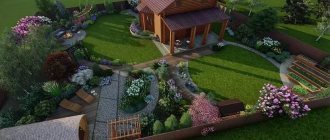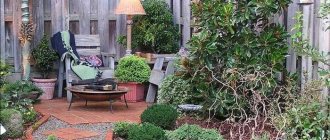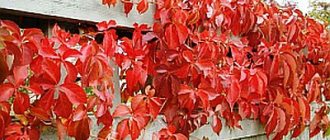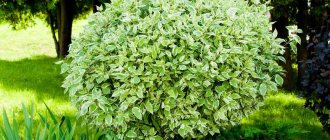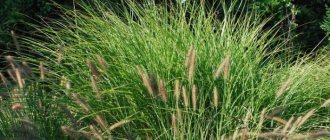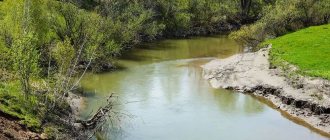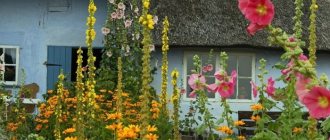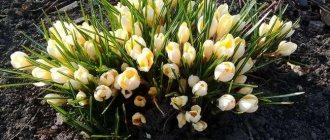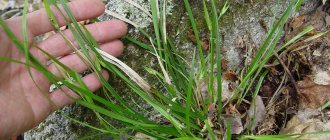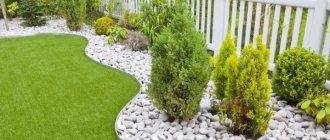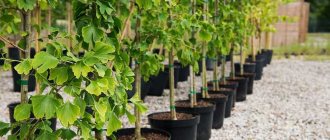Classification
Among the whole variety of conifers, a group of low plants is distinguished. It includes varieties whose age representatives (3-5 years of life) reach the height of a person and the width of his arm span.
Today, planting spruce, pine and juniper trees in the country is becoming increasingly popular. Such compositions fit harmoniously into almost any plot or garden design, complementing the overall picture with bright colors and unusual textures. When choosing them, it is worth paying attention to some features of the growth of these samples.
Nana, dwarf, prostrata - the presence of one of these forms in the name of the variety indicates its short stature.
Dutch gardeners, based on annual height growth, use a conditional breakdown of all conifers into the following categories:
- Full-grown - about 30 cm per year.
- Medium height (semi-dwarf) – 15-30 cm.
- Dwarf - no more than 15 cm.
- Mini dwarf - up to 10 cm.
- Micro dwarf - up to 5-8 cm, some grow no more than 3 cm per year.
Pine dwarf
This species is more common in Eastern Siberia and the Far East, as well as in Japan, Korea and Manchuria. The dwarf pine is a shrub with a usually curved trunk and branches creeping along the ground. If a tree points upward, it grows no more than 5 m.
This pine grows quite slowly and reaches a height of two meters by the age of twenty. It has soft and fluffy needles with small shiny cones, the seeds of which can be eaten. Thanks to its shallow root system, the shrub can easily cope with rocky or sandy soils.
The plant does not like overheating and stagnation of water. It has high resistance to frost. Ephedra is most often planted in a rock garden or on a slope to secure it.
Kinds
Each of the conifers includes a wide variety of low-growing varieties. Below, in alphabetical order, are the most popular options for growing in limited conditions of a small area.
Related article:
Thuja turned yellow after winter - what to do, how to help the plant, video
Spruce
One of the most widely presented options, each of which may differ in the color of the needles and crown.
The most popular:
- Alberta Globe. Famous miniature variety from Canada. The growth per year is approximately 2 cm, reaching only 40 cm at the age of 10 years.
- Conica. Cone-shaped, fluffy and thick. Absolutely natural shape that does not require a special haircut.
- Laurin. Originally from Canada, it is often used in the design of park areas, thanks to its unusual cone that tapers towards the top.
- Little Gem. A low variety of common spruce. Characterized by a rounded crown with a flat top. Height at the age of 10 years is 50 cm, annual growth varies between 2-3 cm.
- Maxwellii. Miniature, compact, often grown in containers or boxes for the New Year holidays.
- Nidiformis. The variety of prickly spruce is characterized by a nesting crown with a flattened middle. Reaches a maximum of 1 m, increasing in width by 3-4 cm annually.
- Echiniformis. A hemispherical plant, a representative of Canadian spruce.
Alberta Globe
Read more about low-growing spruce trees for the garden in the article
Larch
Decorative larches look impressive and original in single plantings or as part of a multi-component composition. The most common varieties are:
- Compacta. The tree is dwarf in size, grows slowly, and is squat. The crown is conical, the branches are densely growing. Withstands temperatures down to minus 34 degrees Celsius.
- Kornik. Up to 1.5 m, trunks are mainly grown. The branches are dense and directed upwards. The needles are a rich bright green tone.
- Larix Decidua. The crown is openwork, and by autumn it turns yellow-golden. Winter-hardy.
Related article:
Low spruce trees for the garden
The only genus of conifers in which needles drop during the winter is larch.
Juniper
A group of creeping plants with a wide variety of dwarf and low-growing varieties:
- Wiltonii. A slow-growing juniper, the average height of which is approximately 10 cm. It goes well in multi-component plantings, and is also planted solitary against the background of large stones or lawn grass.
- Green carpet. A large, spreading bush with a diameter of up to 1.5 m, growth varies between 10-15 cm. It is resistant to frost and does not require frequent watering.
- Pfitzeriana Compacta. Wide (up to 2 m in volume), up to 30 cm tall. Grows quickly in a horizontal plane, the shoots are soft.
- Repanda. Compact, low (up to 30 cm). The crown is flat, the needles do not prick. Resistant to harsh growing conditions.
- Spotty spreader. Spreading (up to 2 m in diameter), dwarf shrub no more than 20 cm. A distinctive feature is that the ends of the shoots turn creamy over time.
Wiltonii
Green carpet
Pfitzeriana Compacta
Repanda
Spotty spreader
Fir
It is considered a shrub with a fast growth rate. The ideal place for planting is an area in partial shade with protection from drafts and gusts of wind. It is demanding on the soil - it grows well on drained fertile soils with uninterrupted access to water (without stagnation of liquid). The most common are the following:
- Nana. Balsam fir variety. Dwarf type up to 0.8 m tall. The crown can spread 2.0-2.5 m.
- Tundra. Refers to Korean fir. Characterized by thick, dense needles. The shoots create a ball of regular shape up to 0.4 m.
Related article:
The thuja is drying up. How to help
Nana
Tundra
Pine
Among mini conifers, many gardeners call pine species the most unpretentious and undemanding in care. They are characterized by a voluminous crown and tufts with sharp needles. Depending on the variety, the bunch and the number of needles in it may differ slightly. The secret to successful cultivation is to follow all the rules of proper planting and carefully care for the seedling in the first year.
Interesting to know: The most beautiful types of pine trees
The following types of pine trees are most often used for gardening:
- Winter Gold. A hemispherical crown with a squat appearance is characteristic. Grows up to 0.5 m and up to 1 m in diameter.
- Gnome. It can reach 1 m, the crown is spherical, the needles are long.
- Compacta Glauca. The maximum height in the central zone of the Russian Federation is 3 m; in other regions there are samples much lower. The needles are long - 8-9 cm, have a rich green-blue color. The branches grow densely upward. Moderately acidic and moist soils are suitable for cultivation.
- Mini Pug (Mina Mops). Grows up to half a meter. It grows flattened and slowly (up to 2 cm per year). It is considered light-loving; in shady areas, growth deteriorates until it completely dries out.
- Ophir. The shape is correct, round. Over time, it grows strongly to the sides, losing its attractiveness.
Gnom
Almost all mountain pines can be trimmed, giving it the desired volume.
Hemlock
Originally from Canada, an adult plant is no more than 1 m in height. Characterized by massive growth of shoots on the sides and their drooping downwards. The needles are small, about 2 cm in size. Resistant to frost, grows well even in shady places.
Thuja
Low-growing thujas are a popular option for decorating and landscaping the local area and garden. Due to their compactness and originality, they are also suitable for planting in containers or for decorating hedges or borders.
In order not to make a mistake with the place to plant the thuja, it is worth looking at its needles. Yellow color indicates the need to choose a sunny place, green - an area with slight shade or partial shade is suitable.
Known:
- Amber Glow. It has a beautiful yellow and gold color, which changes to amber when winter arrives. Ideal for borders and mixed borders.
- Aurea Nana. The branches are vertical, forming an egg-shaped crown. Often planted in wooden containers or in the corners of the site.
- Danica. Maximum parameters can be up to 0.8 m in height and 1 m in volume. It grows spherically, has dark green needles with shine, which are located vertically.
- Caespitoza. Compact, with fan-shaped branches. By winter, the needles turn bronze. Withstands up to minus 29 degrees Celsius.
- Hoseri. Dwarf, crown - a ball with height and width parameters up to 50 cm. Shade-tolerant, easy to trim.
Amber Glow
Aurea Nana
Danica
Caespitoza
Hoseri
What to remember
- to choose coniferous plants for the garden from three types: yew, cypress, and pine. They are most adapted to garden conditions.
- The most popular varieties of low-growing and dwarf conifers are: mountain pine "Winter Gold", balsam fir "Hudsonia", Lawson cypress "Minima Aurea", common juniper "Compress", Scots pine "Pendula", low-growing spruce "Nidiformis".
- Certain rules must be followed to create a healthy and harmonious landscape composition.
- You can create landscape compositions using ready-made designs.
- It is advisable to dilute compositions of coniferous plants with deciduous shrubs and flowers.
Application in garden architecture
Miniature conifers are widely used in the following design options for a garden, local area or summer cottage:
- group and single plantings - under high fences or walls of buildings (as a background for a flower bed), solitary or multiple compositions in the center of the lawn, as a hedge;
- as a complement to the overall picture of a flower bed, rock garden, alpine slide, flower garden or ridge;
- planting in wooden boxes, containers or flowerpots placed at the main entrance to the house, in the yard or along paths;
- landscaping of summer terraces, gazebos or recreation areas.
Blue Carpet
Spruce Minute
Spruce Minuta forms an almost perfectly even spherical crown; in an adult tree it is decorated with miniature cones. Young shoots are bright green, later they darken somewhat. Multi-colored patches of dwarf spruce trees look delightful along the hedge of a small garden.
The plant is quite sensitive to frost, so in cold weather it will have to be covered. It does not like swamps, and in case of stagnation of water, the soil is drained by adding natural material. However, along streams and rivers this dwarf conifer feels quite good.
The tree prefers sandy and loamy acidic soils. Grows well in the shade and tolerates dry climates.
Advantages
The great popularity of low-growing conifers for country gardening can be explained by their positive aspects:
- The miniature version is a copy of a tall specimen with an accurate representation of all characteristics and stages of growth.
- The compactness of the parameters makes it possible to plant a larger number of different options on a relatively small plot of land.
- Maintaining high decorativeness of plantings throughout the calendar year.
- An ideal option for decorating rockeries, alpine slides or garden installations using stones, bark or pebbles.
- Variety of applications in landscape design.
- High frost resistance and tolerance to harsh winter periods.
- Low maintenance requirements.
- Possibility of using conifers planted in buckets or other containers in New Year's home decor and celebrations.
How to prune conifers
Use high-quality, well-sharpened garden tools - pruning shears, garden shears, garden saw. After pruning each plant, wipe the cutting blade with a disinfectant solution to avoid spreading infection. Pine trees are pinched by hand.
Forming coniferous plants is not so difficult, but it requires skill and knowledge of the matter. Therefore, the best alternative to this operation would be to purchase compact forms that meet your design. They can be placed in a minimal area and even in a container.
Source
Flaws
The main disadvantages, based on the experience and reviews of experienced gardeners, are the following:
- Low resistance to fungal diseases, the need to use fungicides.
- Risk of damage to branches and crown as a whole.
- Short lifespan of some varieties.
- Problematic propagation by cuttings.
- The possibility of burning of young needles when exposed to direct sunlight during peak hours in the spring and summer.
How to choose the right one for design
Dwarf conifers are plants that give you the opportunity to design the landscape design of your site as correctly as possible. Thanks to their compact size and slow growth, you can easily predict what the exterior will look like in a few years.
Did you know? Coniferous trees have long been considered a symbol of permanence.
When selecting dwarf evergreen varieties, decide for what purpose you will use them: as a tapeworm or for landscaping a flower arrangement and harmonizing group plantings of coniferous and deciduous crops.
So, any of the plants mentioned above is suitable as a tapeworm. The main thing is to choose harmonious textured plantings for it. If a low-growing coniferous specimen grows surrounded by other crops, then it is important to select such neighbors for it so that against their background the dwarf variety does not get lost and simply die.
Tips for choosing
A wide variety of dwarf plants for the garden are offered by various online trading platforms, gardening and gardening stores, as well as growing nurseries. It is necessary to purchase seedlings from trusted producers.
When choosing samples, be sure to study the seller’s information regarding characteristics and care. A mandatory point when purchasing is the presence of a massive clod of earth, occupying at least 1/3 of the entire seedling in size. Elastic, richly colored needles are considered an indicator of high quality planting material. When transporting, it is better to take burlap for temporary packaging.
Where to plant ↑
The advantage of small species of shrubs is that they do not need to be cut; they look beautiful almost anywhere against the background of low flowers or in a composition with taller shrubs.
They look especially impressive in a combination of greenery and stones. A small conifer planted in the center of the flowerbed will give it additional charm. And creeping species will cover not-so-beautiful areas of land.
If you plan to create a decorative composition from several types, consider how they will look in 5-10-15 years. Holes for planting must be dug “for growth” so that after a few years the plants do not interfere with each other.
Mountain pine Sherwood Compact
Consider the vertical profile of the composition in advance, because they will all stretch out differently.
Do not plant dwarf conifers in the shade of deciduous trees. Falling leaves create a favorable background for the proliferation of pests.
Recommendations for agricultural technology
When planting and further care, you must adhere to some simple rules:
- Deadlines. Planting is carried out in late April - early May, this period depends on the climatic zone of a particular region.
- The dimensions of the hole should be such that the earthen ball around the seedling fits completely inside the recess. It is necessary to plant on a hill in the center, while aligning the roots. Fill with soil, compact and water. Some gardeners use mulching with peat, bark or mown grass.
- Care consists of periodic weeding, loosening and watering. It is also worth regularly inspecting the shoots for the presence of pests or the appearance of the first symptoms of diseases.
Low conifers are an ideal solution for landscaping and landscaping a local area or summer cottage. Such low-growing species can be compactly placed in a small area, creating a harmonious composition of the overall architecture of the garden or yard. Simple and undemanding care, as well as high frost resistance, allow them to be grown in almost all climatic zones.
Features of growing low-growing varieties of conifers
Small forms of conifers have growing rules that are common to all species. Planting is carried out at the end of April or beginning of May, depending on climatic conditions. Usually, dwarf forms of seedlings are purchased in specialized stores, and care must be taken to ensure that the quality of the material is high. The main thing is to check the integrity of the earthen coma; it must be at least ⅓ of the entire seedling, otherwise the plant may not take root. It is worth paying attention to the rich color of the conifer needles and their elasticity; these indicators indicate the good quality of the seedling.
Advice! The best temporary packaging for the root system of dwarf conifers is burlap.
Landing is carried out in this way:
- the hole should be slightly larger than a clod of earth;
- a mound is poured in the center, reaching ⅔ of the height of the pit;
- a conifer seedling is placed on the top of the embankment, and the roots are carefully spread along its slopes;
- then the plant is buried, simultaneously compacting the soil;
- the seedling is well watered;
- dry soil should be poured around the trunk;
- The final stage of planting is mulching the soil with peat.
Caring for dwarf conifers involves watering, sanitary and, if necessary, decorative pruning. In winter, it is worth removing excess snow so that it does not break thin branches and trunk.
Basically, dwarf conifers are susceptible to the following diseases:
- Brown schutte is a very common disease; it is a fungus that mainly affects young specimens. The needles become brown and covered with a gray-black coating. It is treated with preparations containing copper and fungicides.
- Rust - fungus causes orange spots to appear, which then turn into brown growths. Slow down the growth and development of the tree. Drugs such as Fitosporin-M and Abiga-Pik are used.
- Gray mold or rot - gray mycelium appears on the needles. Fungicides are effective against it.
- Fusarium - a fungus that causes the plant to dry out. The needles begin to turn yellow, become rough to the touch and fall off. The whole plant gradually dries out. It is almost impossible to cure a tree; Fundazol is used for prevention.
Pests of small forms of conifers include:
- Bark beetle - lives under the bark, making many moves there. They live mainly in forest plantations and can spread from there to a summer cottage. The insect selects weak trees that die as a result of such an invasion. They fight the pest with the help of special preparations.
- Sawfly - under this name many insects are united, attacking mainly spruce and pine. Pests eat shoots that dry out and break. They get rid of them using special preparations or an ash solution.
- Hermes are parasitic insects that drink plant sap. Seals form on the tree, branches are also deformed, and buds are destroyed. The method of control is insecticides.
- Scale insects - attack dwarf thujas, yews and junipers. The needles turn brown, then turn yellow and fly off. The tree becomes weaker and dies. Insecticidal preparations are effective against scale insects. Onion peel is suitable as a folk remedy.
Thuja occidentalis "Teddy"
One of the smallest types of spherical thuja. It does not even grow to 50 centimeters; usually its height is only 30−35 cm. The plant is famous for its decorative characteristics. The branches are thin - 5−7 mm, evergreen, formed into a spherical crown. The needles are soft, dark emerald in color, turning brown in the winter season. In spring the color is renewed. Thanks to its delicate needle-like leaves, the thuja received another name - soft-needle.
It is better to plant it under diffused sunlight, as too bright light causes the needles to burn out. In the shade it will lose its decorative effect (the crown loses density, the shoots stretch towards the light). It is important that there is no stagnation of water during rain or melting snow, and that the thuja is protected from drafts. For the winter, it is better to tie the crown so that the thin branches do not become deformed under a layer of snow.
Fir "Diamond"
This is a special dwarf plant because it is not bred by breeders.
Its creator is nature itself. The crown of such a green diamond grows in the form of a pillow. The needles of the tree are thick and soft; you won’t be able to prick your hands on them even if you wanted to. The needles are rich green above and blue-white below. If you touch the needles, a pleasant aroma will spread in the air. The maximum height of a natural dwarf is 60 cm. VKontakte
How to care
Caring for dwarf plantings is not difficult. In order for your miniature plant to maintain an attractive decorative appearance, water it regularly in the summer (recommended 2 times a week) and shade the crown if it grows in open sun in order to protect the needles from burns. Also periodically loosen the soil and clear it of weeds that can cause fungal diseases.
For the winter, cover the crown with burlap or spruce branches, and mulch the soil around the plant with leaves, sawdust, peat or straw. In the spring, it is recommended to inspect the crop and carry out sanitary pruning of damaged or dried branches. Such simple rules are the key to the longevity of a miniature plant and its attractiveness.
Important! To ensure that a young plant quickly acclimatizes to new conditions, add a growth stimulator, for example, Kornevin, to the water for irrigation.
Creating a bright and attractive landscape design is impossible without planting fragile but prickly dwarf coniferous plantings. These plants will give the landscape static and stability. Even during the winter cold, they will be able to revive the landscape design and give it bright colors. And the unpretentiousness and undemanding nature of low-growing coniferous crops in care only adds to their advantages.
